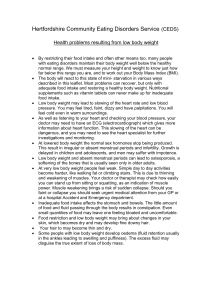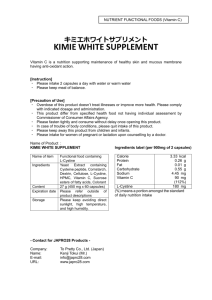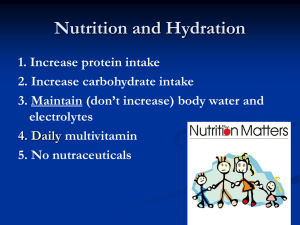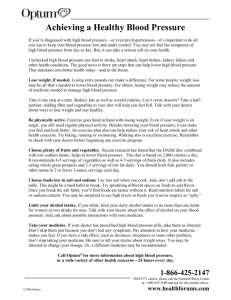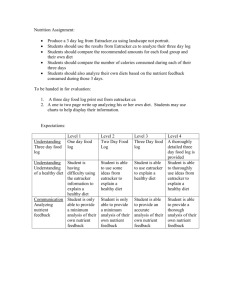FSA Nutrient and Food Based Guidelines for UK Institutions
advertisement
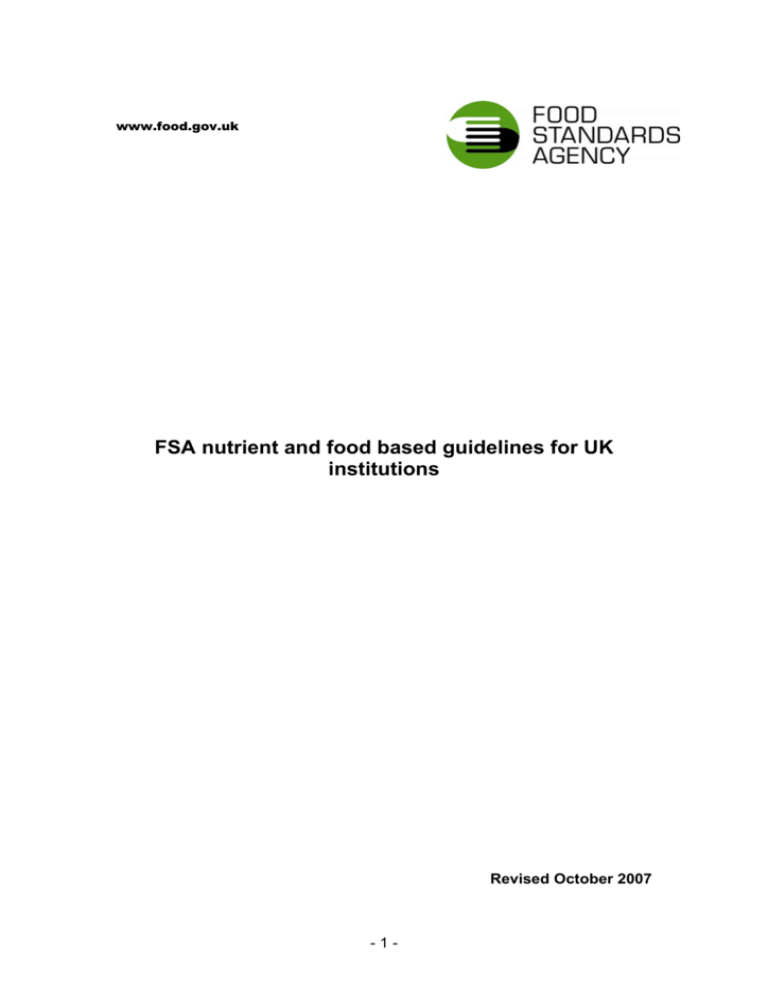
www.food.gov.uk FSA nutrient and food based guidelines for UK institutions Revised October 2007 -1- Healthy Eating Advice 1. The Government recommends that all individuals should consume a diet that contains: • • • • • plenty of starchy foods such as rice, bread, pasta and potatoes (choosing wholegrain varieties when possible) plenty of fruit and vegetables; at least 5 portions of a variety of fruit and vegetables a day some protein-rich foods such as meat, fish, eggs, beans and non dairy sources of protein, such as nuts and pulses some milk and dairy, choosing reduced fat versions or eating smaller amounts of full fat versions or eating them less often just a little saturated fat, salt and sugar 2. The Eatwell plate is a pictorial representation of the proportion that different food groups should make to the diet. This representation of food intake relates to individuals over the age of 5. 3. Although most individuals should be able to get all the nutrients they need from following a healthy balanced diet, certain groups within the population may need to take supplements, these include: -2- • Women who could become pregnant or who are planning a pregnancy are advised to take an additional 400 micrograms (mcg) of folic acid per day as a supplement from before conception until the 12th week of pregnancy. In addition to this, they should also eat folate rich foods such as, green vegetables, brown rice and fortified breakfast cereals (making a total of 600 mcg of folate per day from both folate rich foods and a supplement). Pregnant and breastfeeding women should also take a daily 10mcg supplement of vitamin D. • Children under the age of 5 who are not good eaters may need to take a supplement containing vitamins A, D & C. Children who have a good appetite and eat a wide variety of foods, including fruit and vegetables, might not need vitamin drops. Parents who are concerned about their child’s diet should talk to their GP or health visitor for further advice. 4. The action of sunlight on the skin is the major source of vitamin D and some adults particularly may not receive sufficient sunlight if they spend large periods of time indoors. Adults in these groups may require additional vitamin D. Government advice for this population group is that vitamin D may be required as a 10 microgram (mcg) supplement daily. This advice applies to the following groups of people: • • • • • • women who are pregnant or breastfeeding older people those of Asian origin those who always cover up all of their skin when outside those who rarely get outdoors those who eat no meat or oily fish 5. Food based guidelines for the general public reflect recommendations for nutrient intake based on advice from the Committee on Medical Aspects of Food and Nutrition Policy (COMA) and the Scientific Advisory Committee on Nutrition (SACN). In 1991, the Department of Health published Dietary Reference Values (DRVs) which cover a range of intakes for most nutrients 1 . DRVs for total fat, fatty acids, starch, sugars and fibre (as non-starch polysaccharides, NSP) were set as a percentage of daily energy intake for adults in addition to those for energy and some vitamins and minerals. DRVs for children have not been set for some of these nutrients and, in particular, it should be noted that children below the age of five with small appetites, who need energy-dense diets, should not be restricted in their fat intake. 1 Report on Health and Social Subjects 41 Dietary Reference Values (DRVs) for Food Energy and Nutrients for the UK, Report of the Panel on DRVs of the Committee on Medical Aspects of Food Policy (COMA) 1991. The Stationary Office. London -3- 6. Current recommendations for fat, carbohydrates (including sugars) and fibre for the population are: Saturated fatty acids Polyunsaturated fatty acids Monounsaturated fatty acids Trans fatty acids Total fat Non-milk extrinsic sugars Intrinsic and milk sugars, and starch Total carbohydrate Fibre as non-starch polysaccharide (g/day) *Only applicable to children over 5 years Population average % of food energy Not more than 11 6.5 13 Not more than 2 Not more than 35 Not more than 11 39 50 18* 7. Recommended maximum daily salt intakes for infants, children & adults 2 Age 0-6 mths 7-12 mths 1 – 3 yrs 4-6yrs 7-10yrs 11yrs + Target average salt intake (g/d) Less than 1 1 2 3 5 6 8. Recommendations for protein, vitamins and minerals vary by age. Where different intakes for males and females are recommended, the higher value is identified in the table below to ensure that the greatest needs of the group is met: 2 Scientific Advisory Committee on Nutrition (2003) Salt and Health. The Stationary Office. London -4- Nutrient Protein Iron Zinc Vitamin A 1-3yrs 15g 7mg 5mg 4-6yrs 20g 6mg 6.5mg 7-10yrs 28g 9mg 7mg 11-14yrs 42g 14.8mg 9mg 15-18yrs 55g 14.8mg 9.5mg 400mcg 400mcg 500mcg 600mcg 700mcg 70mcg 30mg 2g 100mcg 30mg 3g 150mcg 30mg 5g 200mcg 35mg 6g 200mcg 40mg 6g (retinol equivalents) Folate Vitamin C Salt2 Nutrient Adults 19-50 years Protein Iron Zinc Vitamin A (retinol equivalents) Folate Vitamin C Salt2 55g 14.8mg 9.5mg 700mcg 200mcg 40mg 6g Adults 50 years and above 53g 9mg 9.5mg 700mcg 200mcg 40mg 6g 9. We know from the National Diet and Nutrition Surveys 3 4 5 that while on average, the population consumes about the right amount of total fat, the highest consumers of fat are eating close to 50% of their energy as fat; far greater than recommended amounts. 10. These surveys also tell us that on average the population consumes too much saturated fat, salt and non-milk extrinsic sugar (NMES, some people call this added sugars). We also know that for different sections of the population, some people have intakes of vitamins and minerals below recommended levels. Guidelines 11. The development of nutritional guidance for institutions represents a repackaging of Government advice to assist caterers and consumers to meet the dietary reference values identified by COMA and SACN. Guidelines have been developed that give advice for those who provide all of the food for those in their care as well as for individual eating occasions. 3 Gregory, J (2000) National Diet and Nutrition Survey: young people aged 4 to 18yrs. The Stationary Office. London 4 Henderson et al (2002) National Diet and Nutrition Survey: adults aged 19 to 64yrs. The Stationary Office. London 5 Finch, S (1998) National Diet and Nutrition Survey: older people aged 74yrs +. The Stationary Office. London -5- 12. Nutrient intake across the day is conventionally divided across four eating occasions, namely breakfast, lunch, evening meal and food consumed between meals (snacks). Given that a wider range of foods tend to be consumed in lunch and evening meals compared to breakfast, these conventionally are assigned a greater proportion of intake. 13. The Agency’s guidance for institutions will assume that, breakfast contributes 20% of daily energy and nutrient intake, with lunch and evening meals contributing 30% each. Foods consumed between meals (snacks) will contribute 20% of daily energy and nutrient intakes. 14. Agency advice will be provided as intake appropriate for the named section of the population which meet average needs. We will call this value the average population requirement. 15. Given the NDNS data indicating the need to lower fat, especially saturated fat, salt and NMES intake and for some populations groups increased intakes of some vitamins and minerals it would be appropriate to consider whether different sections of the population have specific dietary insufficiencies/excesses that could be addressed through food provision in these settings. 16. Consideration, therefore, will be given to assisting those with specific potential dietary insufficiencies to improve their diet through increasing the contribution of these nutrients in the food provided. Nutrients that are recognised to be below recommended intakes could be provided in increased amounts relative to the energy content of meals, to protect individuals at risk of insufficiency. For the purposes of Agency advice to institutions, insufficiencies will be identified where more than 5% of a stated population group have intakes below the Lower Reference Nutrient Intake (LRNI). LRNI is the amount of nutrient that is enough for a small number of people who have the lowest requirements. Most people will need more than this value. 17. Additionally, nutrients, such as salt, where intake is greater than recommended amounts could be provided in lower amounts relative to the energy content of meals to prevent excess consumption. It is acknowledged that initially caterers might find it difficult to meet recommendations for salt intake. However, reformulation by manufacturers and retailers over time will make this easier. Caterers and those responsible for buying food are encouraged to discuss their lower salt requirements with their suppliers, requesting that lower salt options are supplied wherever possible. 18. To help caterers assist their customers in addressing these excesses and insufficiencies, Agency advice will therefore also provide target recommendations where these are appropriate. For fat, salt and NMES, where excesses are apparent, the Agency suggests these target recommendations should be equivalent to 98% of the average population -6- requirement covering all meals and snacks. For vitamins and minerals where insufficiencies are apparent the Agency suggests these target recommendations should be such that, in general, 100% of the average population requirement is provided from breakfast, lunch and evening meals. This is summarised in the following table: Percentage of daily intake energy, protein, fibre Breakfast Lunch Eve meal Snacks Total 20 30 30 20 100 total /sat fat, sugar, salt vitamins and minerals (where insufficiencies are apparent) average target# population requirement average population requirement 20 30 30 20 100 29 29 98 or less 20 30 30 * 100 # target 35-40 35-40 100 or more # - target for nutrients where excess or insufficiencies are apparent. *Snacks will provide additional micronutrients to contribute to the micronutrient target of 100% or more over the day. Care should be taken not to encroach upon maximum safe levels of intake. 19. The Agency believes that it is also important to provide advice on foodbased approaches which reflect the nutritional standards, thereby assisting caterers in achieving them. 20. Examples menus will also be provided that show the sorts and amounts of foods and drinks that could be served to meet the nutrient guidance and food-based advice. Wherever possible, these will provide menus using foods and dishes close to the current provision options available in institutions and includes an appropriate level of choice. These example menus will also include at least 5 portions of a variety of fruit and vegetables a day and provide 2 portions of fish a week, including one portion of oily fish in line with government healthy eating advice. 21. In some institutions standards for the provision of food may be written into contracts. The Food Standards Agency recommends that those responsible for the contracts for food provision in institutions set and monitor standards in this area in order to assist those consuming food provided by them in meeting Government recommendations. 22. Many caterers employ registered nutritionists or dietitians who are able to assess menus against Government recommendations. The Food Standards Agency recommends that assessment against the guidance in -7- this document will ensure that nutrient intake of those, without specific medical dietary need, consuming food provided by institutions will be met. In undertaking any such assessment it is important that the analysis uses appropriate software with up to date information (as a minimum the most recent edition of McCance & Widdowson 6 ) and takes accounts of cooking losses and waste. We also recommend that those responsible for commissioning food provision in institutions request such information and check this with actual provision to ensure the needs of clients are met. Priority Groups 23. Nutrient and foods based guidance that enables the dietary targets identified above to be met, will differ according to the specific section of the population provided for by an institution and among those providing food for individual eating occasions or the whole day. 24. Within the four UK countries, specific vulnerable or priority groups have been identified. Additionally, similar work in other areas of institutional provision, e.g. prisons and the armed forces, is already underway. 7 The Agency will therefore be providing guidance for adults*, such as, older people/care homes and those provided for through other local authority provision, NHS (including staff and visitors), prisons, Armed Forces, higher and further education and central and local government. 25. Guidance is already available or underway in relation to the provision, for example, for looked after children and in schools/nurseries. The Agency is not looking to provide additional advice for these settings. We note, however, that guidance for children in other settings will be consistent, where appropriate, with the guidance already in place. * Diets for medical conditions will not be part of this work 6 Food Standards Agency (2002) McCance and Widdowson’s The Composition of Foods, Sixth summary edition. Cambridge: Royal Society Chemistry. 7 Choosing Health making healthy choices easier, Department of Health, (2004). -8-



